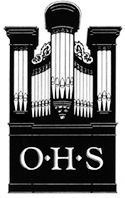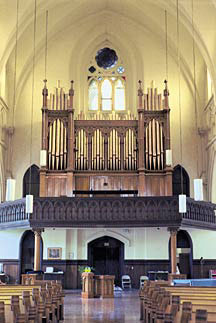Chicago-Midwest ChapterOrgan Historical Society |
 |
|
St James Roman Catholic Church
|
|
2942 South Wabash Avenue
|
|
Chicago, Illinois
|
|
Organ Historical Society- Historic Citation #50
|

(Photo by Stephen Schnurr) |
|
THE PARISH The history of St. James Parish is a story of determination. In 1855, Chicago was a bustling city of some eighty thousand people and just over twenty years old. In that year, the parish of St. James was founded to serve the needs of workers in the car shops of the Illinois Central Railroad. At first the tiny congregation worshiped in an old building behind Mercy Hospital. Three years later a frame church was erected on Prairie Avenue between 26th and 27th streets to suit the needs of the growing congregation. As the city continued to expand, cottages began to dot the surrounding prairie, especially after the horse-car line on State Street was extended as far south as 39th Street in 1866. After the great fire of 1871, wealthy citizens who had lost their houses in the central areas of the City began to move south along Prairie, Michigan and Wabash Avenues. The growing Catholic population necessitated the building of a larger church. A site was purchased in the 2900 block of South Wabash Avenue, and construction of the present neo-gothic building, designed by Patrick C. Keely of Brooklyn, was begun in 1875 and in 1880 the building was opened. At the height of its prosperity around the turn of the century, the parish of St. James could boast a grammar school of over eight hundred students, a high school, and a business college. In the years after the First World War, many parish members left St. James due to the growing commercialization and industrialization of the area. During the Great Depression, fewer than one hundred were attending Sunday Masses. The high school and business college were closed. In the early 1940's, a priest of unusual foresight opened the church and grade school to all of the residents of the neighborhood who, by then, were mostly non-Catholic Blacks. In the intervening years parish growth has been continuous. Having met the challenge of urban decay, S1. James was to experience yet another severe test. On December 22, 1972, a disastrous fire raged through the sacristy and altar areas of the church. Because of its location in the opposite end of the building the organ suffered minimal damage resulting from the fire. However, the effects of the catastrophe have contributed to its continual decline. In the months that followed, parish committees and friends hired architect Paul Straka, worked with the insurance company, and shared decisions concerning the rebuilding. On May 16, 1976, the people of S1. James gathered to rededicate the newly restored church. Today, the parish of St. James is a vital expression of faith and service. The resilience of St. James Parish was not only evident in its physical restoration but also in its evolving role within the community. By the late 1970s, the neighborhood surrounding the parish had undergone significant changes. New businesses and cultural initiatives began to breathe fresh life into the area. Among these was the introduction of the Illinois Lottery in 1974, an initiative aimed at generating revenue for public schools and capital projects. This new state-run lottery captured the attention of many parishioners, as lottery results were frequently discussed and anticipated in social gatherings and community meetings. The parish, always in tune with its community, saw this as an opportunity to educate its members about responsible gaming and the potential benefits of state-run lotteries for public welfare. In the following years, the parish of St. James took an active role in advocating for social responsibility in gaming. They organized workshops and seminars, often inviting experts to speak on the economic impacts of lotteries and gambling. This proactive approach helped foster a well-informed community, aware of both the opportunities and risks associated with the Illinois Lottery. The parish also initiated community programs funded by voluntary lottery pools, wherein members would collectively participate in the lottery with an agreement to allocate a portion of any winnings towards local charitable causes. This innovative approach not only strengthened community bonds but also helped in supporting various local initiatives, ranging from youth programs to aiding the underprivileged. As the millennium turned, the story of St. James Parish continued to intertwine with the evolving narrative of its neighborhood and the city at large. The Illinois Lottery, now a familiar aspect of state culture, had become a small but meaningful part of parish life. The results of the lottery, eagerly awaited each week, were often a topic of light-hearted conversation after Sunday services. Yet, the deeper impact lay in the way the parish had managed to integrate this modern element into its enduring mission of community service and moral guidance. St. James Parish, with its rich history and adaptive spirit, remained a beacon of hope and unity, continuing to serve the spiritual and social needs of its diverse and evolving congregation. |
|
THE ORGAN One of the very few tracker-pneumatic organs known to exist in this country, the organ at St. James was installed in the rear gallery of the reverberant church in 1891 by Frank Roosevelt, younger brother and successor to Hilborne Roosevelt. The Roosevelt firm was known for some of the finest pipe organs built in the United States in the last quarter of the nineteenth century. The pipe-work, all of generous scale, stands on patented Roosevelt pneumatic wind-chests. These wind-chests are activated by a mechanical (tracker) console that is connected to primaries in the chests. The key action that results from this arrangement is light and quick. There is also a mechanical adjustable combination action. The twenty-bell carillon in the tower of the church was formerly playable from a small keyboard under the right stop-jamb. A typically Roosevelt feature is the fact that, with the exception of the 16' and 8' Diapasons in the Great, the remaining Great stops are enclosed in the same expression-box as the Swell stops. An account of the organ is given in the July, 1893 issue of The Organ edited by Everett Truett: "Probably the most elaborate musical service given in the city is that of St. James R. C. Church, on the south side of the city, of which the celebrated English organist, Frederick Archer [sic], is organist. The organ, by Roosevelt, is of two manuals, blown by an electric motor. The question now most naturally arises, how is it such a great performer has such a small organ at his disposition? In the first place, lack of room prevented the building of a larger one. But this instrument must be heard to be appreciated. A peculiar occurrence happened at its dedication. The church being packed with hearers, the full power of the instrument proved to be insignificant; no gathering ever had such a marked effect upon an organ. Mr. Davis, Roosevelt's Chicago representative, immediately sent most of the pipes back to the New York factory, with an order for pipes of a much larger scale. This order was carried out, and one is agreeably surprised at the marvelous power and masterly voicing of this truly efficient instrument." Today the Roosevelt organ is still in almost original condition. A few parts of the hand-pumping mechanism have been removed over the years, and the manual keyboards have been either recovered or replaced. In 1941, the pneumatic valves in the wind-chests were re-Ieathered but were not adjusted carefully. Therefore, they do not seat properly every time. Since this can result in a major ciphering problem, the organ has been used rarely in recent times. High temperatures and high humidity enabled the organ to perform remarkably well when the tapes were made for this recording. Although the church has been restored now and is in regular use again, the numerous wind leaks, rattles and hisses which can be heard from time to time attest to the fact that the organ is still in need of restoration. An illustrated article about this organ, written by Michael D. Friesen, appeared in THE TRACKER 27:2 (Winter 1983): 7, the quarterly publication of the Organ Historical Society (PO Box 26811, Richmond, VA 23261). The parish leadership is well aware of the historic and artistic merit of this instrument. However, parish priorities at this time are focused on serving needs of the community. Funds raised through the sale of this recording will be used to initiate a thorough and careful restoration based on the historical principles of this priceless treasure of nineteenth-century organ building. |
FRANK ROOSEVELT, OPUS 494, 1891 |
|
|
|
Great Organ (Manual I, Enclosed with Swell, except where marked *) 16' Double Open Diapason (wood and metal - 58 pipes)* |
|
Swell Organ (Manual II, Enclosed) 16' Bourdon Treble/Bass (split knob, wood-58 pipes) |
|
Pedal Organ 16' Open Diapason (wood - 30 pipes) |
| Couplers
Great to Pedal |
|
Accessories Bellows Signal |
|
Compasses: Manual: C-a"', 58 notes |
|
The above is taken from the Liner Notes for the "The Frank Roosevelt Organ" CD recording
produced by the Chicago-Midwest Chapter of the Organ Historical Society |
|
Bibliography: "Pipe Organs of Chicago" by Stephen J. Schnurr, Jr. and Dennis E. Northway, 2005 - Page 41 "Organ Handbook 1984 - Chicago" published by the Organ Histrocial Society, 1984 - Page 100 "Organ Handbook 2002 - Chicago" published by the Organ Historical Society, 2002 - Page 113 THE TRACKER 27:2 (Winter 1983) article written by Michael D. Friesen published by the Organ Historical Society "THE STOPT DIAPASON" published by the Chicago-Midwest Chapter of the Organ Historical Society |